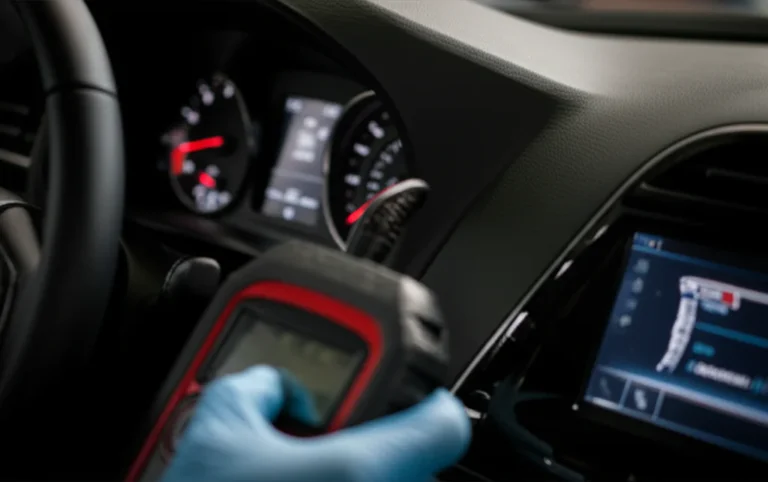Support our educational content for free when you purchase through links on our site. Learn more
Can You DIY Car Repairs? 12 Tasks to Tackle or Trust a Pro 🔧 (2025)
Ever found yourself staring at your car’s dashboard, wondering, “Can I fix this myself, or should I call a mechanic?” You’re not alone. At Car Brands™, we’ve seen countless enthusiasts roll up their sleeves — sometimes with triumphant success, other times with costly lessons learned. Did you know that nearly 60% of car owners attempt at least one DIY repair, but only half finish it without needing professional help? That’s why knowing which repairs you can safely handle and which ones require a pro’s touch is crucial.
In this comprehensive guide, we’ll walk you through 12 common car repairs, breaking down the complexity, safety considerations, and cost benefits of DIY versus professional service. From simple oil changes to the nerve-wracking brake jobs, we’ll share insider tips, personal anecdotes, and expert advice so you can confidently decide when to grab your wrench — and when to make that call.
Key Takeaways
- DIY repairs save money and build confidence but require the right tools, knowledge, and safety precautions.
- Routine maintenance tasks like oil changes, air filter swaps, and battery replacements are perfect for DIYers.
- Complex or safety-critical repairs (transmissions, brakes, electrical systems) should be left to professionals.
- Investing in quality tools and learning to read your car’s warning signs can prevent costly mistakes.
- Keeping detailed repair records protects your warranty and helps build a trusted relationship with your mechanic.
Ready to start your DIY journey or make smarter repair choices? Dive into our detailed breakdown and expert insights ahead!
👉 Shop essential DIY tools and parts:
Table of Contents
- ⚡️ Quick Tips and Facts
- 🕰️ The Evolution of Auto Repair: From Driveway DIY to Dealership Diagnostics
- 🤔 The DIY Dilemma: Weighing the Pros and Cons of Home Auto Maintenance
- 🛠️ Your Toolkit or Theirs? Deciding Who Does the Dirty Work
- 💰 Show Me the Money! A Deep Dive into DIY vs. Professional Repair Costs
- 🛡️ Beyond the Wrench: Safety First and Protecting Your Car’s Warranty
- 🔧 Essential Tools for the Aspiring Home Mechanic: What You Really Need
- 💡 Decoding Your Dashboard: Understanding Warning Lights and What They Mean
- 🛑 When to Call It Quits: Recognizing Your Limits and Avoiding Costly Mistakes
- 🤝 Building Your Automotive A-Team: The Value of Records and Reputable Mechanics
- 🚧 Common DIY Car Repair Mistakes to Avoid Like the Plague
- 🔮 The Future of Car Repair: What’s Next for DIYers and Professional Shops?
- ✅ The Ultimate Decision: Is DIY Auto Repair Right for YOU?
- 🏁 Conclusion: Balancing Savings with Safety and Sanity
- 🔗 Recommended Links for the Savvy Car Owner
- ❓ FAQ: Your Burning Questions About Car Repair Answered
- 📚 Reference Links
⚡️ Quick Tips and Facts
Welcome to the ultimate showdown: DIY car repairs vs. professional mechanics! At Car Brands™, we’ve rolled up our sleeves, popped open hoods, and wrestled with wrenches to bring you the lowdown on when to grab your tools and when to dial up your trusted mechanic. Whether you’re a weekend warrior or a cautious car owner, these quick tips will help you steer clear of costly mistakes and keep your ride humming smoothly.
- DIY repairs can save you 50-70% on labor costs — but only if you pick the right jobs. (The Wrench Works)
- Safety first! Some repairs, like brakes and transmissions, demand professional expertise to avoid accidents.
- Basic maintenance tasks like oil changes, air filter swaps, and battery replacements are perfect for beginners.
- Invest in quality tools: a reliable socket set, jack stands, and a torque wrench can be your best friends.
- Keep detailed records of any DIY work to protect your warranty and maintain resale value.
- Know your limits: If a repair feels overwhelming or requires specialized diagnostics, call in the pros.
Curious about which repairs you can confidently tackle yourself? Stick around — we’ll break down the good, the bad, and the downright tricky of car repairs. Ready to get greasy? Let’s dive in!
🕰️ The Evolution of Auto Repair: From Driveway DIY to Dealership Diagnostics
Back in the day, car repairs were a family affair. Dad’s garage was a sanctuary where grease-stained hands and the smell of motor oil were badges of honor. Fast forward to today, and cars are rolling computers with complex electronics, turbocharged engines, and safety systems that would baffle even seasoned mechanics.
The Golden Age of DIY
- 1950s-1970s: Cars were simpler beasts — carburetors, mechanical brakes, and no onboard computers. DIY repairs were common, and manuals like the Haynes series were prized possessions.
- Tools: Basic hand tools, jacks, and wrenches sufficed.
- Community: Neighborhood mechanics and enthusiasts shared tips over coffee.
The Rise of Complexity
- 1980s-2000s: Electronic fuel injection, anti-lock brakes (ABS), and onboard diagnostics (OBD) transformed cars into high-tech machines.
- Tools: Specialized scanners and diagnostic tools became essential.
- DIY Challenge: Without access to expensive equipment, many repairs became impractical for home mechanics.
Today’s Landscape
- Modern Cars: Advanced driver-assistance systems (ADAS), hybrid and electric drivetrains, and complex emissions controls.
- Professional Shops: Equipped with manufacturer-level diagnostic tools and trained technicians.
- DIY Revival: Thanks to YouTube tutorials, affordable OBD-II scanners, and online forums, many enthusiasts are reclaiming their garages.
For a deep dive into the history of automotive brands and their repair philosophies, check out our Car Brand Histories.
🤔 The DIY Dilemma: Weighing the Pros and Cons of Home Auto Maintenance
The Upsides of Turning Your Own Wrench: Why DIY Car Repair Rocks!
- 💸 Save Big Bucks: Labor can be 50-70% of repair costs. Doing it yourself means paying only for parts and supplies.
- ⏰ Convenience: No need to wait for an appointment or shuttle rides. Work on your schedule.
- 🧠 Learn & Empower: Understanding your car builds confidence, helps diagnose future issues, and improves communication with mechanics.
- 🔍 Quality Control: Choose your parts — OEM, aftermarket, or performance upgrades — and ensure the job is done right.
- 🌱 Eco-Friendly: Proper maintenance extends vehicle life and reduces waste.
The Pitfalls and Perils: When DIY Auto Repair Goes Wrong
- ⚠️ Safety Hazards: Injuries from falling cars, burns, or electrical shocks are real risks.
- 💥 Costly Mistakes: Over-tightening bolts, using wrong fluids, or improper assembly can cause damage worse than the original problem.
- 🛠️ Tool Limitations: Specialized repairs often require expensive tools not found in the average garage.
- 🕒 Time Sink: What pros do in an hour might take you a weekend.
- 🚫 Warranty Voids: Some repairs can void manufacturer or extended warranties if not done by certified technicians.
Remember, the goal isn’t to become a pro overnight but to become a savvy car owner who knows when to DIY and when to call for backup.
🛠️ Your Toolkit or Theirs? Deciding Who Does the Dirty Work
1. Your Go-To Guide: Car Repairs You CAN Tackle Yourself (and Save Big!)
| Repair Task | Difficulty | Time Required | Tools Needed | Why DIY? |
|---|---|---|---|---|
| Oil Change | Easy | 30-45 mins | Socket set, oil pan, funnel | Saves $30-$50; routine maintenance |
| Air Filter Replacement | Easy | 10-15 mins | None or screwdriver | Simple, improves fuel economy |
| Windshield Wiper Replacement | Very Easy | 5-10 mins | None | Quick fix, better visibility |
| Battery Replacement | Easy | 15-20 mins | Wrench | Saves labor, extends reliability |
| Tire Pressure Check & Inflation | Very Easy | 5 mins | Tire pressure gauge, air pump | Improves safety and fuel economy |
| Brake Pad Replacement* | Moderate | 1-2 hours | Socket set, C-clamp, jack | Saves labor, critical safety task |
*Brake replacement requires caution and proper tools — see our detailed guide below.
Step-by-Step: Changing Your Oil Like a Pro
- Warm up the engine to thin the oil.
- Jack up the car safely and secure with stands.
- Place oil drain pan under the drain plug.
- Remove drain plug and let oil drain completely.
- Replace drain plug with a new crush washer.
- Remove old oil filter and install new one with fresh oil on the seal.
- Refill engine with correct oil type and quantity.
- Check for leaks and reset oil change indicator if applicable.
For detailed tutorials, visit Car Brands™ Car Repairs.
2. Hands Off! Essential Car Repairs Best Left to the Pros
| Repair Task | Reason to Avoid DIY | Risks if Botched |
|---|---|---|
| Transmission Repairs | Complex hydraulics, requires lifts & tools | Complete transmission failure |
| Engine Overhauls | Precision torque specs, specialized tools | Catastrophic engine damage |
| Brake System Overhauls | Safety-critical, requires bleeding & testing | Brake failure, accidents |
| Complex Electrical Diagnostics | Needs expensive scanners & expertise | Electrical fires, module damage |
| Suspension & Steering Repairs | Affect handling and safety | Poor control, tire wear |
| Air Conditioning Service | Requires refrigerant handling license | Injury, environmental harm |
If you’re unsure whether a repair is in your wheelhouse, it’s wise to consult a professional mechanic. Many shops offer free or low-cost inspections to help you decide.
💰 Show Me the Money! A Deep Dive into DIY vs. Professional Repair Costs
Let’s talk numbers — because saving money is a big reason many of us consider DIY repairs.
| Repair Type | DIY Cost (Parts + Tools) | Professional Cost (Parts + Labor) | Estimated Savings |
|---|---|---|---|
| Oil Change (4/year) | $120 | $200 | ~$80 |
| Air Filter Replacement | $15 | $40 | $25 |
| Cabin Air Filter | $20 | $50 | $30 |
| Wiper Blade Replacement | $25 | $60 | $35 |
| Battery Replacement | $120 | $200 | $80 |
| Total Annual Cost | $300 | $550 | $250 |
Initial Tool Investment: Expect to spend around $180-$200 for a decent socket set, jack stands, oil drain pan, and funnel. This means you break even by the second year if you maintain your car regularly.
Pro Tip: Tools are an investment that pay off over time — quality brands like CRAFTSMAN, IRWIN, and BOSCH offer durable sets that last years.
🛡️ Beyond the Wrench: Safety First and Protecting Your Car’s Warranty
Safety Considerations
- Always use jack stands when working under your car — never rely on a scissor jack alone.
- Wear protective gloves and eye protection.
- Disconnect the battery when working on electrical systems.
- Follow manufacturer torque specifications to avoid over-tightening or under-tightening bolts.
- Avoid working on critical systems like brakes or steering without proper knowledge.
Warranty and Legal Implications
- DIY repairs can void warranties if not done according to manufacturer guidelines.
- Use OEM parts or approved aftermarket parts to maintain warranty coverage.
- Keep detailed records and receipts of all parts and work done.
- Some states require licensed professionals for emissions or safety-related repairs.
- Insurance claims may be affected if an accident is linked to improper DIY repairs.
For more on warranty and legal tips, check out our Auto Industry News.
🔧 Essential Tools for the Aspiring Home Mechanic: What You Really Need
| Tool | Purpose | Recommended Brands |
|---|---|---|
| Socket Set (Metric & SAE) | Removing nuts and bolts | CRAFTSMAN, DEWALT, IRWIN |
| Torque Wrench | Tightening bolts to spec | TEKTON, CDI |
| Jack and Jack Stands | Lifting and safely supporting vehicle | Pro-Lift, Torin |
| Oil Drain Pan | Catching fluids during oil changes | Lisle, Hopkins |
| Screwdrivers (Flat & Phillips) | General disassembly | Wiha, Klein Tools |
| Pliers and Wire Cutters | Electrical and mechanical tasks | Knipex, Channellock |
| C-Clamp or Caliper Tool | Compressing brake pistons | OTC, Lisle |
| Tire Pressure Gauge | Checking tire pressure | Accutire, Milton |
| OBD-II Scanner | Reading diagnostic trouble codes | BlueDriver, Autel |
Investing in these basics will set you up for success and safety.
💡 Decoding Your Dashboard: Understanding Warning Lights and What They Mean
Your dashboard is like a car’s language — blinking icons are its way of saying, “Hey, something’s up!” Knowing what these lights mean can save you from expensive repairs or dangerous breakdowns.
| Warning Light | Meaning | DIY Action | When to See a Pro |
|---|---|---|---|
| Check Engine Light | Emissions or engine issue | Use OBD-II scanner to read codes | If codes indicate serious faults |
| Oil Pressure Warning | Low oil pressure | Check oil level immediately | If persists, stop driving |
| Battery/Charging Alert | Charging system problem | Check battery connections | If persists, get professional help |
| Brake Warning Light | Brake system issue | Check brake fluid level | If light stays on, urgent repair |
| Tire Pressure Monitoring | Low tire pressure | Inflate tires to recommended PSI | If light persists, check for leaks |
For a detailed guide on dashboard symbols, visit Popular Mechanics’ Dashboard Guide.
🛑 When to Call It Quits: Recognizing Your Limits and Avoiding Costly Mistakes
Even the most enthusiastic DIYer hits a wall. Here’s how to know when it’s time to hand over the keys to a pro:
- You lack the right tools or space. Some repairs require lifts, diagnostic scanners, or specialized tools.
- The repair involves safety-critical systems like brakes, steering, or airbags.
- You’re unsure about the procedure or torque specs. Guesswork can lead to disaster.
- The problem persists after your attempt. Repeated DIY fixes can cause more damage.
- Warranty or insurance issues are at stake. Professionals protect your coverage.
- You don’t have the time. Some repairs can take days for amateurs.
Remember, a trusted mechanic is your insurance policy against costly mistakes.
🤝 Building Your Automotive A-Team: The Value of Records and Reputable Mechanics
Even if you’re a DIY champ, having a reliable mechanic in your corner is priceless.
Why Build a Relationship?
- Expert advice when you hit a tough problem.
- Reliable diagnostics with advanced tools.
- Quality parts and workmanship with warranties.
- Emergency support when you’re stranded.
Keep Detailed Records
- Document all DIY maintenance and repairs.
- Save receipts for parts and tools.
- Share your records with your mechanic for better service.
This teamwork approach maximizes your car’s lifespan and resale value.
🚧 Common DIY Car Repair Mistakes to Avoid Like the Plague
- Skipping safety precautions: Always use jack stands and protective gear.
- Using incorrect parts or fluids: OEM or approved replacements matter.
- Over-tightening or under-tightening bolts: Use a torque wrench.
- Ignoring manufacturer instructions: Consult the owner’s manual or repair guides.
- Not diagnosing the root cause: Fix symptoms, not problems.
- Rushing the job: Take your time to avoid errors.
Avoid these pitfalls, and your DIY journey will be smoother and safer.
🔮 The Future of Car Repair: What’s Next for DIYers and Professional Shops?
The automotive world is evolving at warp speed:
- Electric Vehicles (EVs): Fewer moving parts but complex battery systems.
- Advanced Driver Assistance Systems (ADAS): Cameras and sensors requiring calibration.
- Connected Cars: Remote diagnostics and over-the-air updates.
- 3D Printing: Custom parts on demand.
- Augmented Reality (AR): Interactive repair manuals and training.
DIYers will need to adapt, learning new skills and investing in tech-savvy tools. Meanwhile, professional shops are becoming high-tech hubs blending traditional skills with digital expertise.
Stay ahead by following our Auto Industry News for the latest trends.
✅ The Ultimate Decision: Is DIY Auto Repair Right for YOU?
Let’s wrap up the big question: Should you roll up your sleeves or call the pros?
Ask yourself:
- Do I have the time, tools, and patience?
- Is the repair simple and low-risk?
- Am I willing to learn and accept occasional mistakes?
- Does the repair affect safety-critical systems?
- Will DIY save me significant money without risking my warranty?
If you answered yes to the first three and no to the last two, DIY is a rewarding path. Otherwise, partnering with a professional mechanic is the smartest move.
Remember, the best car owners are informed ones who balance savings with safety and sanity.
- Socket Sets: TrueCar | AutoTrader | CRAFTSMAN Official Website
- OBD-II Scanners: Edmunds | Amazon | BlueDriver Official
- Brake Pads & Rotors: AutoTrader | TrueCar | Brembo Official
- Jack and Jack Stands: Edmunds | Amazon | Pro-Lift Official
For more insights on car repairs and maintenance, explore our Car Brand Comparisons and Car Brand Lists to find vehicles that are easier to maintain and repair yourself.
Next up: The grand finale — our conclusion and expert recommendations await you!
🏁 Conclusion: Balancing Savings with Safety and Sanity
So, can you perform car repairs yourself, or are some tasks better left to a professional mechanic? The answer is a resounding “it depends” — but with a few guiding principles, you can confidently navigate this decision.
DIY repairs shine brightest on routine, low-risk tasks like oil changes, air filter replacements, battery swaps, and even brake pad changes if you have the right tools and patience. These jobs not only save you a bundle on labor but also empower you with knowledge and a deeper connection to your vehicle. Just remember: safety first! Always use proper equipment, follow manufacturer instructions, and know your limits.
On the flip side, complex repairs involving transmissions, engine internals, advanced electronics, or critical safety systems are best entrusted to professional mechanics. Their expertise, specialized tools, and warranty protections ensure your car stays safe and reliable — and your wallet avoids costly mistakes.
Throughout this article, we’ve shared insights, tips, and real-world advice from the Car Brands™ team and trusted sources like The Wrench Works and Popular Mechanics. Remember, the goal isn’t to become a professional overnight but to become a savvy car owner who knows when to get their hands dirty and when to call in the pros.
Ready to roll up your sleeves? Or maybe just ready to make smarter calls about your car’s care? Either way, you’re now equipped to make informed decisions that balance savings, safety, and sanity.
🔗 Recommended Links for the Savvy Car Owner
-
Socket Sets:
TrueCar Socket Sets | AutoTrader Socket Sets | CRAFTSMAN Official Website -
OBD-II Scanners:
Edmunds OBD-II Scanners | Amazon OBD-II Scanners | BlueDriver Official -
Brake Pads & Rotors:
AutoTrader Brake Pads | TrueCar Brake Pads | Brembo Official -
Jack and Jack Stands:
Edmunds Jack Stands | Amazon Jack Stands | Pro-Lift Official
❓ FAQ: Your Burning Questions About Car Repair Answered
What car repairs can I safely do myself at home?
You can safely perform routine maintenance tasks such as:
- Oil and oil filter changes
- Air and cabin filter replacements
- Windshield wiper blade swaps
- Battery replacement
- Tire pressure checks and inflations
- Brake pad replacements (with proper tools and knowledge)
These tasks generally require minimal specialized tools and carry lower risk when done carefully. Always consult your vehicle’s owner’s manual and use quality parts.
When should I take my car to a professional mechanic?
Seek professional help when:
- Repairs involve critical safety systems (brakes, steering, suspension)
- You face complex engine or transmission issues
- Your vehicle requires advanced diagnostics (electrical or computer systems)
- You lack the proper tools or workspace
- The repair affects your vehicle’s warranty or insurance coverage
- You feel unsure or overwhelmed by the task
Professionals have the training, equipment, and experience to handle these challenges safely and efficiently.
Read more about “What Are the Average Costs of 10 Common Car Repairs? (2025) 🚗”
What are the risks of performing car repairs without experience?
- Personal injury: From burns, cuts, or crushed limbs if safety protocols aren’t followed
- Vehicle damage: Incorrect repairs can cause further mechanical failures or safety hazards
- Voided warranties: Unauthorized repairs may nullify manufacturer or extended warranties
- Increased costs: Mistakes often lead to more expensive repairs down the line
- Legal and insurance issues: Some repairs require licensed professionals to comply with laws and insurance policies
How can I learn basic car repair skills?
- Online tutorials and videos: YouTube channels like ChrisFix and Scotty Kilmer offer step-by-step guides
- Repair manuals: Haynes and Chilton manuals provide detailed instructions tailored to your vehicle
- Community classes: Local community colleges or automotive shops sometimes offer beginner courses
- Hands-on practice: Start with simple tasks like changing wiper blades or checking fluids
- Forums and groups: Join car enthusiast forums or social media groups for advice and support
What tools do I need for DIY car repairs?
A basic toolkit should include:
- Metric and SAE socket sets
- Torque wrench
- Jack and jack stands
- Screwdrivers (flathead and Phillips)
- Pliers and wire cutters
- Oil drain pan and funnel
- Tire pressure gauge
- C-clamp or brake caliper tool
- OBD-II scanner for diagnostics
Investing in quality tools from brands like CRAFTSMAN, IRWIN, and TEKTON will save frustration and money in the long run.
Read more about “How to Find 12 Reliable Mechanics for Your Car Repairs (2025) 🔧”
Are there car repairs that require specialized equipment?
Absolutely. Repairs such as:
- Transmission rebuilds
- Engine overhauls
- Advanced electrical diagnostics
- Air conditioning system servicing (requires refrigerant handling licenses)
- Suspension alignment and calibration
- ADAS sensor calibration on modern vehicles
These require expensive tools, training, and sometimes legal certification, making them unsuitable for DIY.
How much money can I save by doing my own car repairs?
Savings vary by repair type and your skill level, but:
- Routine maintenance like oil changes and filters can save $50-$100 per service
- Brake pad replacements can save $100-$200 per axle
- Battery replacement saves $50-$100 in labor
- Over a year, DIY maintenance can save $200-$500 or more compared to professional service
Remember, initial tool investment and time spent learning are factors to consider. Over time, DIY can be a rewarding and cost-effective approach.
📚 Reference Links
- The Wrench Works: DIY vs. Professional Car Repairs
- Auto Air & Heating Repair: DIY vs. Professional Auto Repairs
- Popular Mechanics: How to Replace Vehicle Brakes
- CRAFTSMAN Tools Official
- BlueDriver OBD-II Scanner Official
- Brembo Brakes Official
- Pro-Lift Jack Stands Official
For more expert advice and detailed guides, visit our Car Repairs section at Car Brands™.







